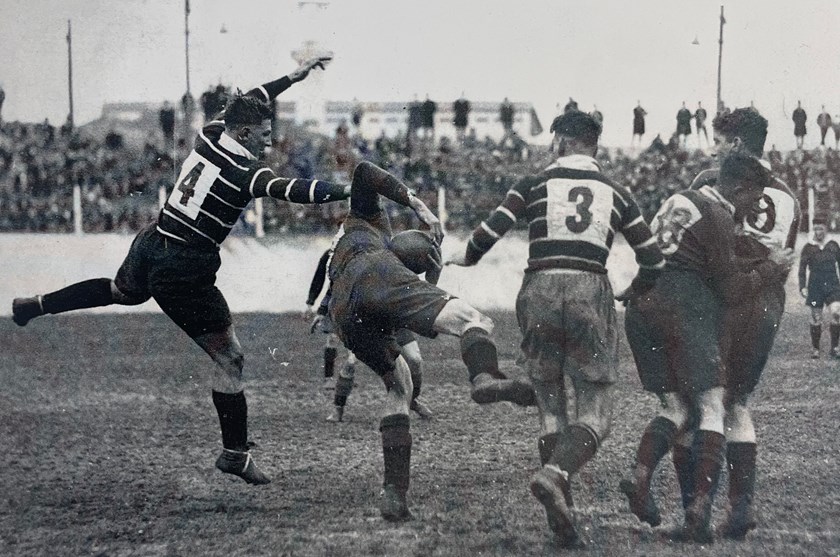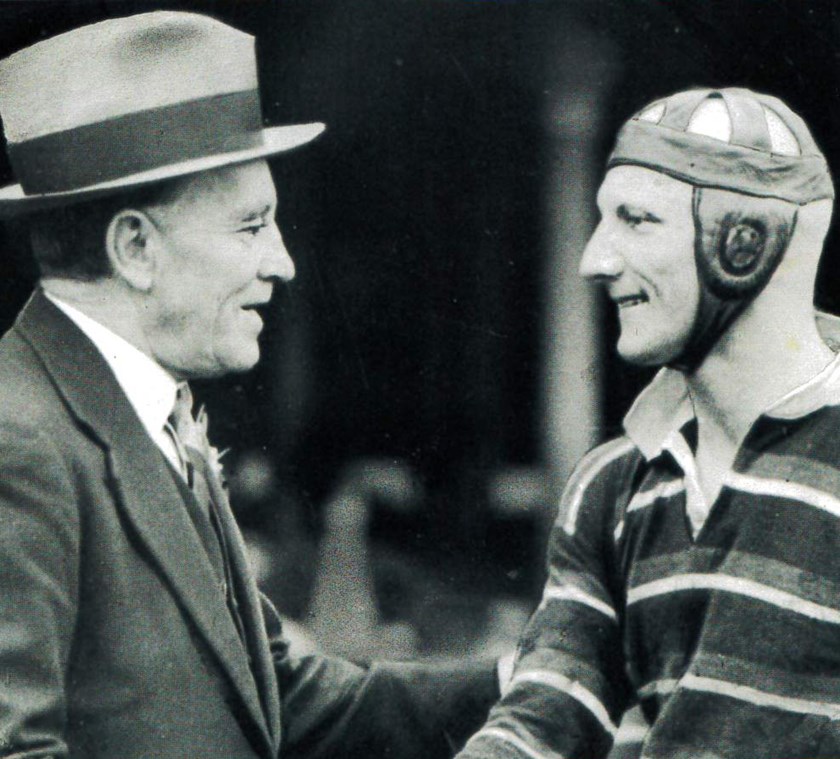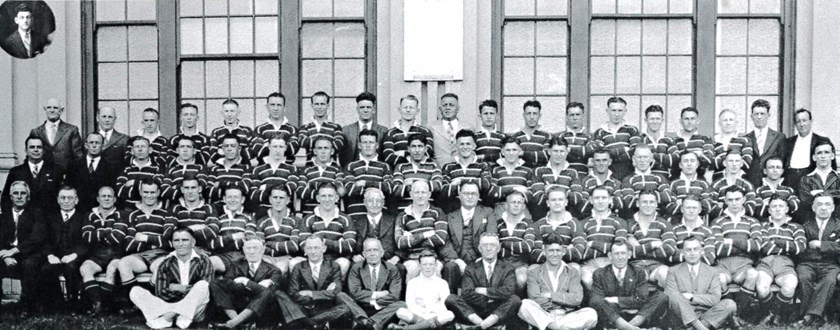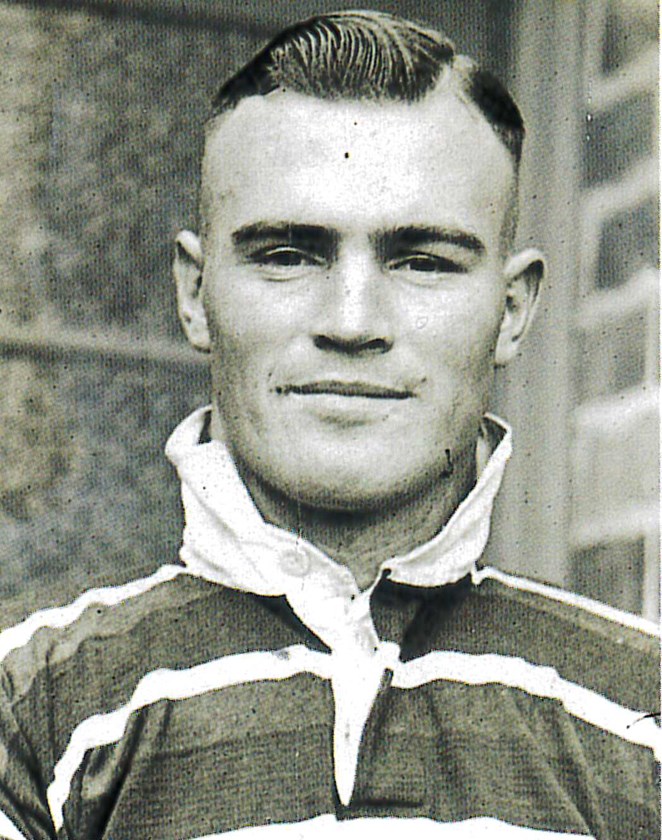1930 - 1939

Highlighted by the superstar performances by the likes of Dave Brown, Joe Pearce, Ray Stehr and Viv Thicknesse, the Tricolours' triumphs in the 1930s not only brought success to the Club but helped to blunt the impact of The Great Depression.
The Club claimed a hat-trick of Premierships from 1935-1937, were runners-up twice and only missed the finals on one occasion, that being in 1939 in what is regarded as one of the greatest decades not only in Club history but in the code's as well.
1930 - Changing of the Guard
| Played: | 15 |
| Won: | 11 |
| Lost: | 4 |
| Drawn: | 0 |
| Final Position: | Semi-Finalists |
The 1930s began with plenty of changes made in the squad - Joe 'Chimpy' Busch was named as captain in his final season at the Club, while former skipper Arthur Oxford joined the coaching staff.
Former champion halfback and premiership winner in 1912-13 Arthur 'Pony' Halloway came in as Head Coach, and the Tricolours started their season strongly with six wins from the opening eight matches, before losing just one game before the finals to finish in second place.
The side missed out on a place in the final, however, falling agonisingly short in the Semi-Final against St George, 10-11 at Earl Park, despite scoring more tries than their opponents.
They did, however, claim silverware in 1930, becoming the inaugural holders of the Fred Flowers Memorial Pennant as Club Champions which was won in a canter, such was the production line growing at Easts.

As written in an entry in The Rugby League News (Vol. 19 no.4, May 7, 1938) the Pennant was described as follows:
"This competition, which was inaugurated in 1930, to perpetuate the memory of the Rugby League's late President, the Hon. Fred Flowers, M.L.C., has been won six times by Eastern Suburbs and twice by the South Sydney District Clubs.
The method of allotting points is as follows: First Grade competition points to be multiplied by 4; Reserve Grade by 3; Third Grade by 2.
The club having the highest aggregate in all grades at the end of the second round to be declared club champions; points scored in the semi-final and final matches will not count. In the event of two or more clubs being equal, competition points for and against, will decide the destiny of the Pennant, which will be the trophy for the champions."
The season also marked the debut of a 17-year-old centre named Dave Brown, who played his first match against St George in Round 9 and would go on to be the most influential player in the decade for the Red, White and Blue.
Debutants: Jack Hickey, Jenkin Joseph, Jack Lynch, Les Rogers, Fred Tottey, Dave Brown, Perc Atkinson
1931 - Making Strides
| Played: | 16 |
| Won: | 12 |
| Lost: | 4 |
| Drawn: | 0 |
| Final Position: | Runners Up |
A 40-2 thrashing of University in Round 1 - which also marked the first time Dave Brown, Ray Stehr, Joe Pearce and debutant Ernie Norman would line up alongside one another - proved that life would go on for the Eastern Suburbs men.
Norm Pope took over the captaincy role as the side won its opening nine matches with only two losses all season to emphatically claim the Minor Premiership.
However, a close 8-10 Semi-Final loss to defending Premiers Western Suburbs saw the Tricolours exercise their right to a challenge but were ultimately defeated by South Sydney in the Grand Final Challenge 7 to 12 in a gallant effort to finish off another strong season.
Debutants: Hilton Delaney, Max Nixon, Ernie Norman, Roy Paillas, Ray Gillam, Colin Smith
1931 Eastern Suburbs Tour of New Zealand
| Date | Opponent | Score | Venue |
|---|---|---|---|
| October 8th | Northland | 23-11 (W) | Kensington Park |
| October 10th | Devonport United | 41-27 (W) | Carlaw Park |
| October 14th | South Auckland | 23-14 (W) | Steele Park |
| October 17th | Combined Marist Bros Devonport | 13-14 (L) | Carlaw Park |
| October 21st | Auckland Colts | 18-13 (W) | Carlaw Park |
A post-season tour of New Zealand, where the side won four of their five games in Auckland, saw the cross-code arrival of halfback Viv Thicknesse, who started in the second grade but quickly made his way to the firsts side and cemented a position the following year.
1932 - Semi-Finalists Once Again
| Played: | 15 |
| Won: | 9 |
| Lost: | 6 |
| Drawn: | 0 |
| Final Position: | Semi-Finalists |
A young Dave Brown took over as the Club's captain in 1932, which also came with a change at the helm as Glebe legend Frank Burge coached his one and only season at the Club.
Brown's tenure at skipper couldn't have started in better fashion, with the side winning the opening five matches and sitting in first place. Consecutive losses to Souths and Balmain were responded to with four consecutive victories, including shutouts of University (20-0) and Newtown (40-0).
But the end of the season finished in miserable fashion, with a string of losses to end the season including a Semi-Final defeat to South Sydney 8-26 - the Tricolours were close, but not close enough.
Debutants: Viv Thicknesse, John Clarke, George Shankland, Jim Morrison, Eugene Paillas, Jack Gray-Spence, Jack Guinery, W. Rayner

1933 - Incomplete and Depleted
| Played: | 15 |
| Won: | 8 |
| Lost: | 6 |
| Drawn: | 1 |
| Final Position: | Semi-Finalists |
The Kangaroo Tour of 1933 played a massive role in the destiny of the Eastern Suburbs side that year. At the end of July the Tricolours held top spot, but the departure of star players Dave Brown, Viv Thicknesse, Ray Stehr and Joe Pearce led to another season falling just short.
Arthur 'Pony' Halloway returned to coach after a year's absence, with Joe Pearce taking over the captaincy duties. A three-match winning streak - including a 22-14 win at Marrickville against eventual Premiers Newtown - sparked a promising start, only to be followed by four losses and a draw.
In sixth position at the beginning of July, the Red, White and Blue pulled themselves up to second on the ladder after recording five wins from the next six games, and were - by reports - incredibly unlucky to go down to St George in the Semi-Final 10-13.
Debutants: Jack 'Buster' Craigie, Jack Fay, Harleigh Hanrahan, John Lane, Laurie Ward, Tom Dowling, Walter Anderton, George Court, Fred Robinson, Bob Halloway, Bob Stuart, Eddie Wood, Gordon Whitton
1934 - On the Brink of Greatness
| Played: | 17 |
| Won: | 13 |
| Lost: | 4 |
| Drawn: | 0 |
| Final Position: | Runners Up |
Winning three of their opening five games, the 1934 Eastern Suburbs side embarked on a nine-match winning streak through the middle of the season between Rounds 6 and 14, finishing the season on equal points with Western Suburbs.
A Play-Off match determined the Minor Premiers - despite Easts finishing with a superior for and against - with Wests pipping the Tricolours 7-2.
Victorious in the Semi-Final against Souths 19-6, Eastern Suburbs reached the Final against their old adversary Wests, but again were trumped by a small margin 12-15 after the match was postponed (the first in the competition's history) one week due to heavy rain and adverse ground conditions.
Dave Brown equalled the top tryscoring charts with eleven tries, and was the year's highest point scorer with 121 points, and he would soon find his name in lights the following season...
Debutants: Jack Beaton, Fred Buchanan, Andy Norval, Harry Pierce, R. Thompson, Tom McLachlan, Theo Lang
1935 - Dave Brown's Dynasty
| Played: | 18 |
| Won: | 17 |
| Lost: | 1 |
| Drawn: | 0 |
| Final Position: | Premiers |
The Tricolours started season 1935 in arguably their best-ever form - winning the first seven matches which included a 61-5 thrashing of University, a 57-9 walloping of North Sydney and the Club's biggest victory in an 87-7 demolition of new club Canterbury-Bankstown.
Captain Dave Brown announced himself as the best player in the game in the match against Canterbury-Bankstown, scoring 45 points with 5 tries and 15 goals, and finished the season with 38 tries, both records which stand today.
Needing two points to break Dally Messenger's point-scoring record in the final round of the competition, Brown did so seamlessly in the first two minutes of the match with a solo try and finished the match with five more. Messenger congratulated Brown at half-time, and teammates chaired him off the field after the sublime 80 minutes.

On June 22, 1935 the Eastern Suburbs District Rugby League Football Club lost their Round 8 match against South Sydney 11-18. The players and officials didn't know it at the time, but it marked the last loss for the Tricolours until April 25, 1938.
Despite being without Brown in the Premiership Final due to injury, the Red, White and Blue made easy work of rivals Souths in a 19-3 victory - claiming the Club's 5th Premiership and marking the beginning of a dynasty.
The Arthur Oxford-coached reserve grade also claimed the Premiership, going undefeated through the regular season with 15 wins and one draw, with the thirds finishing second on the ladder but losing in the semi-final.
Debutants: Ross McKinnon, Rod O'Loan, Gordon Favell, Les Trusler, Bill Halloway
1936 - Back to Back Champs
| Played: | 15 |
| Won: | 13 |
| Lost: | 0 |
| Drawn: | 2 |
| Final Position: | Premiers |
The Tricolours' dominance of the NSWRFL continued into 1936, with a strong opening-round win over Souths (26-9) before going on a seven-match winning streak heading into the finals, which included a 50-12 drubbing of University in Round 14.
A Dave Brown hat-trick in the Semi-Final led to a convincing 25-13 victory over Canterbury-Bankstown, before Easts put Balmain to the sword in the Final in an eight-tries-two performance which saw them claim the title for a second year running.
Debutants: John Beckley, Albert Horsell, Henry McCallum, Johnny Parker, Wal Bamford
1937 - Three-Peat
| Played: | 8 |
| Won: | 6 |
| Lost: | 0 |
| Drawn: | 2 |
| Final Position: | Premiers |
Despite Brown taking up an offer in England, Easts dominated the 1937 season to string together their third consecutive Premiership for the second time in the Club's history.
Halfback Viv Thickness took over as skipper, as the competition reverted back to a 'first-past-the-post' system with the reintroduction of the City Cup at season's end.
From Round 3 onwards, the Tricolours held top spot and never looked likely to drop their lead - and despite two draws to St George and Souths through the season, victory was all but assured for the men from Bondi.
An inexperienced side charged through the City Cup with only two losses from their eight rounds, and despite suffering a heavy defeat in the Final against Newtown, Eastern Suburbs had established themselves as one of the most dominant sides in Rugby League history with the completion of their three-peat.
Debutants: Stan Callaghan
1938 - Change in the Air
| Played: | 16 |
| Won: | 7 |
| Lost: | 6 |
| Drawn: | 3 |
| Final Position: | Runners Up |
With the retirement of Viv Thicknesse, the Club's strong form continued into the opening round win over St George, and the next week lost to Souths in their first defeat in nearly three seasons.
The mighty record at some point had to be broken, and was followed up with back-to-back wins over Newtown and Norths - and while a six-week slump with no wins could have resulted in the side sliding down the ladder.
Firebrand forward Ray Stehr took over the captaincy and lit a fuse in the side and recovered to win their final two matches of the season, and claimed a 19-10 victory over South Sydney in the Semi-Final.

Reaching their fourth consecutive Final, but fell short 6-19 against Canterbury-Bankstown in an otherwise great season for the Club, which ended with a four-match tour of New Zealand.
Debutants: Jack Arnold, Lionel Pawley, Aden Cairns, Dick Dunn, Jack McCarthy, Doug Bartlett, Noel Hollingdale, Jim Norton, Laurie Pickup, Percy Dermond, Frank Bell
1938 Eastern Suburbs Tour of New Zealand
| Date | Opponent | Score | Venue |
|---|---|---|---|
| September 24th | Marist Old Boys | 36-13 (W) | Carlaw Park |
| September 28th | Manukau | 16-7 (W) | Unknown |
| October 1st | Richmond | 11-9 (W) | Carlaw Park |
| October 4th | South Auckland | 17-5 (W) | Davies Park |
1939 - First Finals Miss, Brown Returns
| Played: | 14 |
| Won: | 8 |
| Lost: | 6 |
| Drawn: | 0 |
| Final Position: | 5th |
Now Captain-Coach of the side, Ray Stehr's men were unable to make the finals for the first time since 1929 - but with that came the positive news of the return of Dave Brown.
Winning their first three matches including a 20-9 replay of the previous year's Final against Canterbury in the opening round, Eastern Suburbs looked like their form would continue from the previous season, only for a mid-season slump to rue their chances of qualifying for the finals.
But the return of Brown in the final two matches after getting an early release from his contract garnered two victories to end the season on a positive note, one that would roll into the following season.
Debutants: Larry O'Malley Jnr, Mick Rankine, Les O'Donnell, Les Robinson, Harold 'Mick' Dalton, Harry Nobbs, Frank Vaughan

Sydney Roosters respect and honour the Traditional Custodians of the land and pay our respects to their Elders past, present and future. We acknowledge the stories, traditions and living cultures of Aboriginal and Torres Strait Islander peoples on the lands we meet, gather and play on.





